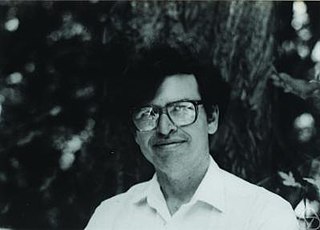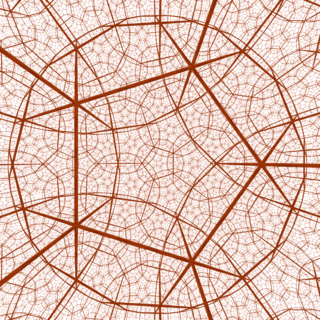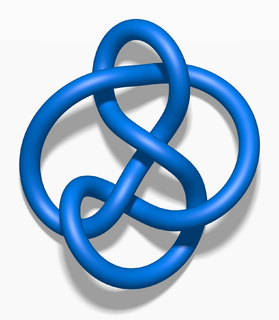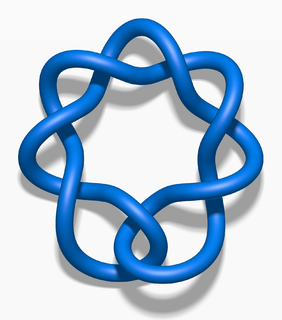
William Paul Thurston was an American mathematician. He was a pioneer in the field of low-dimensional topology. In 1982, he was awarded the Fields Medal for his contributions to the study of 3-manifolds. From 2003 until his death he was a professor of mathematics and computer science at Cornell University.

In knot theory, a figure-eight knot is the unique knot with a crossing number of four. This makes it the knot with the third-smallest possible crossing number, after the unknot and the trefoil knot. The figure-eight knot is a prime knot.

In the mathematical field of topology, knot theory is the study of mathematical knots. While inspired by knots which appear in daily life, such as those in shoelaces and rope, a mathematical knot differs in that the ends are joined so it cannot be undone, the simplest knot being a ring. In mathematical language, a knot is an embedding of a circle in 3-dimensional Euclidean space, . Two mathematical knots are equivalent if one can be transformed into the other via a deformation of upon itself ; these transformations correspond to manipulations of a knotted string that do not involve cutting it or passing through itself.

In mathematics, a 3-manifold is a space that locally looks like Euclidean 3-dimensional space. A 3-manifold can be thought of as a possible shape of the universe. Just as a sphere looks like a plane to a small enough observer, all 3-manifolds look like our universe does to a small enough observer. This is made more precise in the definition below.
In the mathematical field of knot theory, the Jones polynomial is a knot polynomial discovered by Vaughan Jones in 1984. Specifically, it is an invariant of an oriented knot or link which assigns to each oriented knot or link a Laurent polynomial in the variable with integer coefficients.
In mathematics, more precisely in topology and differential geometry, a hyperbolic 3–manifold is a manifold of dimension 3 equipped with a hyperbolic metric, that is a Riemannian metric which has all its sectional curvatures equal to -1. It is generally required that this metric be also complete: in this case the manifold can be realised as a quotient of the 3-dimensional hyperbolic space by a discrete group of isometries.

In mathematics, a hyperbolic link is a link in the 3-sphere with complement that has a complete Riemannian metric of constant negative curvature, i.e. has a hyperbolic geometry. A hyperbolic knot is a hyperbolic link with one component.

In the mathematical theory of knots, a pretzel link is a special kind of link. It consists of a finite number tangles made of two intertwined circular helices, The tangles are connected cyclicly, the first component of the first tangle is connected to the second component of the second tangle, etc., with the first component of the last tangle connected to the second component of the first. A pretzel link which is also a knot is a pretzel knot.

In mathematics, a hyperbolic manifold is a space where every point looks locally like hyperbolic space of some dimension. They are especially studied in dimensions 2 and 3, where they are called hyperbolic surfaces and hyperbolic 3-manifolds, respectively. In these dimensions, they are important because most manifolds can be made into a hyperbolic manifold by a homeomorphism. This is a consequence of the uniformization theorem for surfaces and the geometrization theorem for 3-manifolds proved by Perelman.
In mathematics, the Weeks manifold, sometimes called the Fomenko–Matveev–Weeks manifold, is a closed hyperbolic 3-manifold obtained by (5, 2) and (5, 1) Dehn surgeries on the Whitehead link. It has volume approximately equal to 0.942707… and David Gabai, Robert Meyerhoff, and Peter Milley (2009) showed that it has the smallest volume of any closed orientable hyperbolic 3-manifold. The manifold was independently discovered by Jeffrey Weeks (1985) as well as Sergei V. Matveev and Anatoly T. Fomenko (1988).
In mathematics, hyperbolic Dehn surgery is an operation by which one can obtain further hyperbolic 3-manifolds from a given cusped hyperbolic 3-manifold. Hyperbolic Dehn surgery exists only in dimension three and is one which distinguishes hyperbolic geometry in three dimensions from other dimensions.

In the mathematical field of knot theory, the hyperbolic volume of a hyperbolic link is the volume of the link's complement with respect to its complete hyperbolic metric. The volume is necessarily a finite real number, and is a topological invariant of the link. As a link invariant, it was first studied by William Thurston in connection with his geometrization conjecture.
In mathematics, more precisely in group theory and hyperbolic geometry, Arithmetic Kleinian groups are a special class of Kleinian groups constructed using orders in quaternion algebras. They are particular instances of arithmetic groups. An arithmetic hyperbolic three-manifold is the quotient of hyperbolic space by an arithmetic Kleinian group. These manifolds include some particularly beautiful or remarkable examples.

In knot theory, the three-twist knot is the twist knot with three-half twists. It is listed as the 52 knot in the Alexander-Briggs notation, and is one of two knots with crossing number five, the other being the cinquefoil knot.

In knot theory, the stevedore knot is one of three prime knots with crossing number six, the others being the 62 knot and the 63 knot. The stevedore knot is listed as the 61 knot in the Alexander–Briggs notation, and it can also be described as a twist knot with four twists, or as the (5,−1,−1) pretzel knot.

In knot theory, the 63 knot is one of three prime knots with crossing number six, the others being the stevedore knot and the 62 knot. It is alternating, hyperbolic, and fully amphichiral. It can be written as the braid word

In knot theory, a branch of mathematics, a twist knot is a knot obtained by repeatedly twisting a closed loop and then linking the ends together. The twist knots are an infinite family of knots, and are considered the simplest type of knots after the torus knots.

In three-dimensional hyperbolic geometry, an ideal polyhedron is a convex polyhedron all of whose vertices are ideal points, points "at infinity" rather than interior to three-dimensional hyperbolic space. It can be defined as the convex hull of a finite set of ideal points. An ideal polyhedron has ideal polygons as its faces, meeting along lines of the hyperbolic space.


















